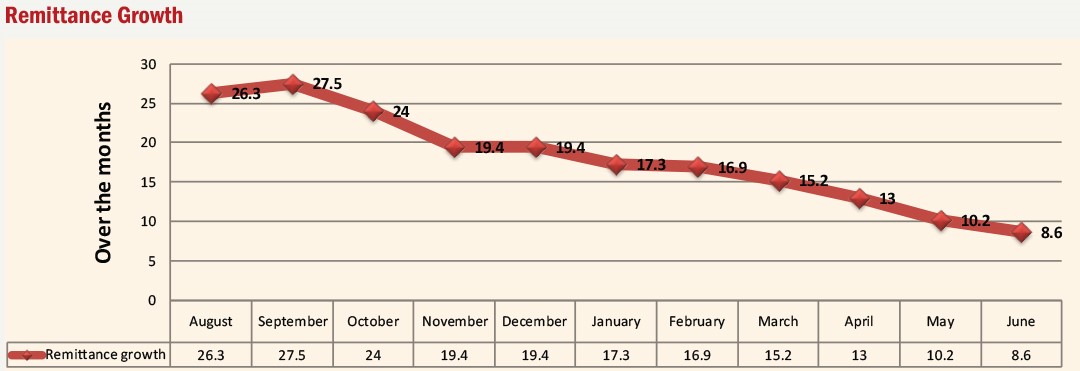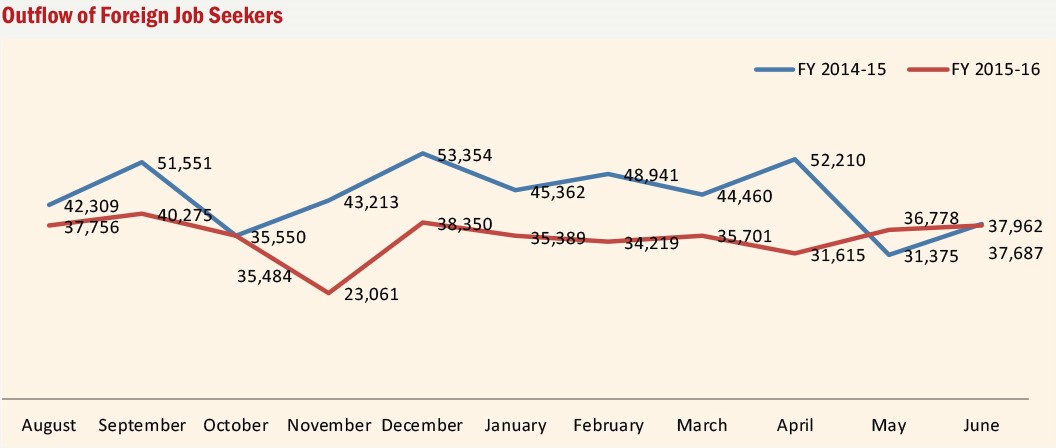
Remittance inflow has been sharply plummeting over the months in the last fiscal which might cause adverse impact to the country’s economy in the near future with Nepal’s large reliance on foreign exchange earnings through remittance.
The country’s overdependence on remittance has been often been portrayed as the ‘Dutch Syndrome.’ Remittance has grown to more than 30 percent of the GDP making Nepal among highest remittance recipient countries (adjusted for the size of the economy) in the world. A small slowdown in remittance for the country can have a broad macroeconomic, poverty and fiscal impacts. Remittance growth has plunged sharply over the months in 2015-16 from peaking 27.5 percent in the second month (September) to 8.6 percent in the eleventh month (June) of the last fiscal, according to Nepal Rastra Bank (NRB). Remittance growth was 23 percent in October and a constant growth of 19.4 percent was witnessed in November and December. Remittance growth slowed down to 17.3 percent in January and 16.9 percent in February, 15.2 percent in March, 13 percent in April, 10.2 percent in May and 8.6 percent in June.


What went wrong?
Countries started witnessing a slowdown in remittance growth globally since 2015 as crude oil prices fell rampantly which directly affected the government and private sector spending of oil exporting countries. Growth rate of global remittance inflow recorded the lowest since 2008 financial crisis. Around four million or 28 percent of Nepal’s total work force has been working abroad. Gulf countries are the major labour destinations for job-seekers. In 2015-16 Nepal to some extent resisted the global trend of remittance slowdown as migrant workers sent more remittance for relief and rehabilitation of their family members in earthquake-hit districts. Rampant fall in oil prices affected the spending of government and private sector in Gulf nations causing severe effect in further job creation. More recently, some countries like Saudi Arabia started adopting austerity measures like cutting jobs for foreign workers to cope with the challenge caused by the oil price fall. The International Monetary Fund (IMF) has said that if lower oil prices persist, remittance outflow from oil-exporting countries is likely to slow down further.
Remittance growth slowed down further as the outflow of foreign job seekers dropped significantly by 20.56 per cent in the first 11 months of fiscal year 2015-16. According to the Department of Foreign Employment, only 386,315 foreign job seekers left the country for employment in the first 11 months of 2015-16 as compared to the corresponding period of 2014-15 when 486,287 jobseekers went abroad. Slowdown in outflow of migrant workers was caused by the rift between government and manpower agencies after the police raided some manpower firms accusing them of swindling money from foreign job aspirants. Manpower firms shut down operations for almost a month. Apart from this, Malaysian government’s decision to stop hiring foreign labour (which got opened just some months back) also contributed to the problem. After the earthquake, many youths have also decided to stay back to help reconstruct their homes and support their families in quake-hit areas.
Near-term risks
Slowdown of remittance will have adverse impact in various segments of the country’s economy. The economy has been crippled by the two major shocks - earthquake and supply side disruptions – are only recently gradually taking pace of recovery. Remittance slowdown in the near term could prove fatal. First, it will directly hit consumption of goods and services as families of migrant workers start cutting expenses, according to Yubraj Khatiwada, Vice Chairman of the National Planning Commission. The expanding service sectors like telecommunications, restaurants, clothing among others will face the impact at the very onset.
A recent report unveiled by the World Bank Group has said that Nepal’s overdependence on remittance to maintain its foreign exchange earnings is an inherently risky strategy as it is vulnerable to external shocks. The report suggested to diversify the sources of foreign exchange earnings.
Medium and long term risks
As the country is going to initiate massive post earthquake reconstruction works, there will be a huge demand for construction materials. Large scale imports of construction material might push the country towards pressure in Balance of Payment because of slow down in remittances. Remittance has played a key role in maintaining foreign exchange earnings ever since the decline in tourist inflow and exports contributing less towards foreign exchange reserve. While the country is still in a comfortable position in terms of BoP surplus worth Rs 171.15 billion in the first 11 months of fiscal 2015-16, if remittance inflow continues slowdown mode, it will add pressure to BoP as import of construction materials surges. In this situation, the government will not have many alternatives except to curb the import of consumable goods and luxury import items. The government has set revenue collection target worth Rs 565.9 billion in the current fiscal 2016-17. Contraction in import will hit government revenue collection because import is also a major source of government revenue wherein it collects 44 percent of total revenue at customs points in the form of customs tariff, value added tax, excise and other taxes. Fiscal deficit is expected to widen if revenue collection drops. The World Bank Report titled ‘Remittance at Risk’ unveiled recently has assumed that with 10 percent drop in remittances, growth rate could drop by up to 3 percentage points. According to economists, prolonged slowdown in remittances may have adverse effect on poverty, while the resulting economic slowdown could increase non-performing loans requiring greater provisions and capital buffers in the banking sector. “Prolonged slow down in remittances will hit the smooth growth of various sectors including banking, which has been contributing Rs 50 - 60 billion to government’s coffers with letter of credit business, other loan expansion as well as loan recovery could drop along with slowdown in economic activities in the country,” said Senior Economist Keshav Acharya, adding, “The country would face inflationary pressure due to low supply against the high demand along with contraction in import of consumable goods.” Continuous slowdown in remittance inflow will pose a challenge for poverty reduction because remittance has played a pivotal role in reducing poverty radically in the last decade. If the labour destinations start cutting jobs citing rampant fall in crude oil prices, then it would be tough to generate jobs for returnee migrants as well as the fresh labour force. This will push large numbers of population below poverty line. Increasing migration of people from villages to urban areas would also create additional pressure on public facilities and infrastructure, explained Acharya.
Past experience
This is not the first time that the country has witnessed a slowdown in remittance growth. Remittance slowdown after plummeting crude oil prices following 2008 global financial crisis had also affected the Nepali economy for two fiscal years 2009-10 and 2010-11. The country had faced BoP crisis in fiscal 2009-10 due to slowdown in remittance inflow and revenue shocks in fiscal 2010-11, following the global financial crisis. The government then had utilised rapid credit facility (RCF) from International Monetary Fund to manage BoP crisis. The government’s move to curb imports of gold and other luxury goods in fiscal 2010-11 after the BoP crisis hit revenue collection as well. Import growth was contracted to 8 percent in 2010-11 from 37 percent in 2009-10 fiscal. Not only revenue collection, contraction in imports in 2010-11 affected the wholesale and retail trade sub-sector. Growth rate of this sub-sector dropped to 1.7 percent from 6.7 percent in 2009-10. “The ultimate impact was visible in the overall GDP growth rate which came down to 3.4 percent for fiscal 2010-11 despite having remarkable agricultural and industrial outputs. The service sector contributed only 1.1 percentage to overall growth,” states the World Bank report.

Way forward
The country’s overdependence on remittance and on man power supply to Gulf countries are not reliable in the long term. The government’s policy of putting all eggs in the same basket may invite a disaster in the country’s economy, explains Ganesh Gurung, a labour migration expert. He suggested the government to negotiate with other possible labour destinations like Japan, South Korea and Israel, among others to diversify the labour destinations. “Because of the fall in oil prices, Gulf nations have started adopting austerity measures or shifting focus on other sectors. In this context, even if one-third of migrant workers are sent back home, there will be a hue and cry because we cannot generate employment for them. So, the government needs to have a contingency plan in place to diversify labour destinations,” Gurung said. The World Bank report also states that healthy migration and related remittance inflow will continue to play an important role for external balance and (disposable) income support. However, Nepal needs to leverage its key resources -human and natural capital - to attract investment and lay foundations for creation of opportunities and economic diversification at home. Senior Economist Acharya, who served as Advisor at the Ministry of Finance during the BoP crisis of 2009-10, opined that the government should bring back high-end workers equipped with good skills and support them in setting up ventures to accelerate enterprise development. He further suggested that government increase incentives to remitters so that they are encouraged to use formal channels to send money back home. Remittance has been playing a vital role in strengthening foreign exchange reserve, but policy makers should give serious consideration and action towards future risks. The government has offered Foreign Employment Bond to migrant workers and Non-Resident Nepalis to transform remittance into wealth creation and enterprise development. It would spur development if capital from these bonds can be directed towards construction of mega irrigation projects which will help delink agricultural output from the effects of monsoon because only 25 percent of the country’s arable land has irrigation facility. Long-term bonds, like foreign employment bonds can reduce excess liquidity in the market preventing cheaper credit flow (which backs inflation) and improve real effective exchange rate and external competitiveness, according to economists.






